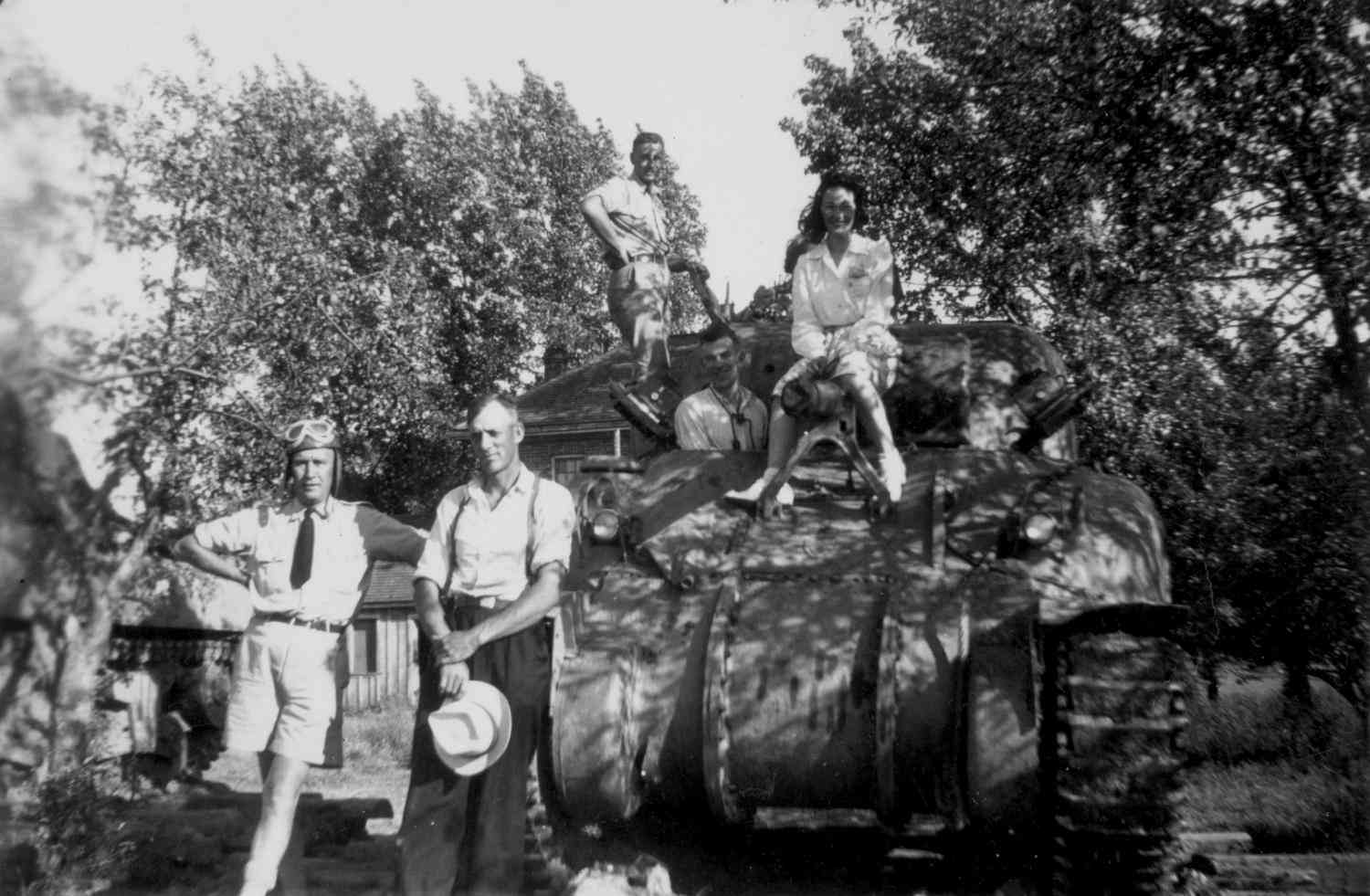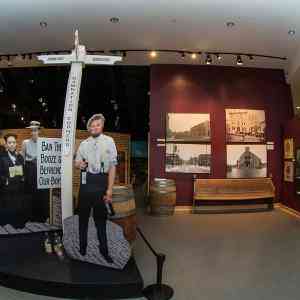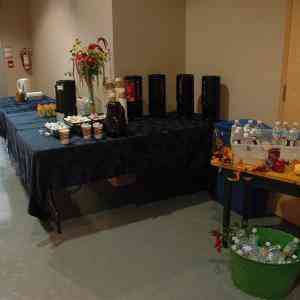Thanksgiving Closure
Grey Roots Museum & Archives will be closed Oct 12, 13 & 14.
Grey Roots Museum & Archives will be closed Oct 12, 13 & 14.

(Photo: Tank at Clark's Homestead near Vail's Point, PF212S1F2I31)
In Time of Need
Canada declared war in September 1939. The success of Hitler’s armoured and mechanized units in Europe created greater need for similar equipment for the Allied forces. No suitable venue was available for such vehicles and training – the terrain at Hawkestone, Ontario, near Oro, was too soft for the heavy tanks and the area too small for increased firing range. Camp Borden was in need of expansion. What was required was an area providing space for battle practice, hard ground, moderate snowfall, close to railway and highway facilities, and a direct firing range of a minimum of 1,000 yards. What was needed had to be affordable and found quickly.
Secret Reconnaissance
Land in the northernmost areas of St. Vincent and Sydenham Townships, near Meaford, was deemed to be most suitable. Major J.M. McAvity, a Chief Gunnery Officer, quietly surveyed the area, and it was declared to meet the needs most satisfactorily. An interesting estimate of the cost to acquire this land – less than the cost of three RAM tanks. Hence, in July 1942, offers were made to property holders.
Much discussion took place amongst the landowners affected, and many felt that the government was not offering enough money for their properties, which had now suddenly become valuable. W.P. Telford, M.P., suggested that better settlement would be received through the courts. It was rumoured that without co-operation, the required land would simply be expropriated. This rumour held true and the expropriate plan was filed at the North Grey Registry Office on July 21, 1942, making the land the property of His Majesty the King.
PF212S1F2I26 Tanks in orchard at Meaford Tank Range
For King and Country
"If Hitler came we would be getting nothing for our farms and I feel that to give our farms up is only a trifle compared to those who are giving their lives. Generally we seem to be getting a fair price." Mrs. James McCartney told The Daily Sun-Times. It would have been considered unpatriotic not to comply.
Little or no time was afforded to owners to negotiate. Much speculation resulted. Many were told that if they did not sell, the government would simply take the land for nothing, and others had the understanding that following the war, they would be able to re-purchase their property. However, having become Crown Land, later settlement was not possible.
No Time to Say Goodbye and Starting Over
Military timelines were tight. Some families were required to vacate in August, for others September 30, 1942, was the final deadline. This necessitated the head of the family finding a new home, and a hurried the packing up of possessions. As well, auctions had to be held to accommodate the move. Harvesting was a hurried affair; some of it simply left standing in the fields. Apples remained on the trees, as it was too early to harvest the fall varieties.
PF212S1F2I22 unidentified group, perhaps military men, c. 1943
For many, it was impossible to hire trucks to accomplish their move, and livestock had to be driven to the new location in many cases. A suggestion was made that army trucks could be used to assist the farmers, but in the end the farmers were left to their own devices.
The St. Vincent Municipal Telephone system worried that their investment of equipment might be lost. The telephones were then removed before the residents were gone, causing even more difficulties.
PF210S2F1I19 Carson Family at Open Sunday, 1943
Land values escalated in areas surrounding the Tank Range. Some of those having to move simply decided to retire from farming, and to look for employment in some other field. A simpler way of life ended in a hurry. In the 1930s and 1940s, the people of Grey County generally had little cash, but there was usually enough to eat. The community spirit of togetherness in community functions, such as shopping in Meaford, likely on a Saturday night, was suddenly gone. Many memories exist, both good and bad. While there was undoubtedly some intimidation, whether real or felt the moves were finalized.
Apples & Artillery
PF210S2F1I14 Tank crossing Bighead River, Meaford
Three RAM tanks arrived at the Meaford trail station on September 29, 1942. School children were dismissed to watch the arrival. The soldiers were billeted in the empty farm houses. The first building on site was the Engineer’s Office. Soon there were 30 one-tonne tanks. Soldiers came from Camp Borden for training. By the time an official opening was held, over 10,000 men had already passed through, and many of those were now fighting in Italy. The Minister of National Defence, Col. J.L. Ralston and the Chief of the General Staff officially opened the Range on October 8, 1943.
Because of the nature of the ground, concrete runways were installed for the tanks. Hangars had been built. The firing range could accommodate up to 200 trainees at a time. The tank range could have seven tanks practicing at one time, and there was a range for crew training in machine gun, mortar and anti-tank 6-pounder use.
Wood was urgently needed by the Massey-Harris company to manufacture wings for Mosquito aircraft. In 1943, permission was granted to take out approximately 9,000 feet of white ash.
Some former owners were concerned about the orchards and apple crops. In October 1942, specified times were granted to allow the harvest of apples. The root crops were harvested by the military and sent to Camp Borden. Following a terrible double fatality with a live mortar, in which two teenagers were killed, civilians were refused entry to the Range in 1945.
The final expropriation encompassed approximately 17,350 acres, affecting 150 farms, four schools and three churches. Also affected were seasonal cottages, hunting cabins, two small summer hotels, two Rotary Camps, while cemeteries were simply left untouched and maintained by the army. A danger area extended out into Georgian Bay, and in 2006, it is a distance of 2,000 metres, marking with yellow warning buoys.
In September 1956, the Meaford Tank Range was involved in one of the largest military training practices since the Second World War. Conducted by Central Ontario Command, this included infantry, armour, artillery, and supporting arms and services.
The Meaford Tank Range and Training Area was used continually until late 1960. It was re-activated in 1973, as it was considered the only central region capable of supporting armoured live fire exercises, combat team training, and static gunnery. Prior to this, consideration had been given to turning it into a National Park, perhaps named for Lester B. Pearson. The cost proved to be prohibitive as dangerous unexploded items still existed.
In 1987, the federal government announced plans to increase the role of Canada's military reserves. In order to achieve this goal, the Militia Training and Support Centre in Meaford became the focal point for training all reserve units in Ontario. The Department of Defence re-activated the camp facilities on a full time basis in August 1989.
Between 1987 and 1995, more than $100 million worth of building, road, waterworks, and sewage upgrades occurred. After receiving the Freedom of the City by the Town of Meaford, in 1995, the base received a new name - Land Forces Central Area Training Centre.
Today, the Centre is deemed state-of-the art, both in the facilities and training it offers. As is handles all of Ontario's regular and reserve training staff every summer, it is one of Canada's largest military training centres. It also employs as many as 300 military and civilian personnel. Unlike many other military bases, the Centre does not offer married quarters. As such, the families of personnel live in the surrounding communities, from Meaford to Owen Sound. The military has made efforts to help heal old wounds caused by the expropriation and any on-going irritation over the base's activities. They provide occasional access to civilians, provide notice of firing times, and assist in community endeavours.

Your membership will grant you access not only to Grey Roots, but also to our partner museums!

Volunteers participate in learning workshops and seminars, meet new people and make new friends, and receive many benefits.

We rent our multi-media theatre and Delton Becker Room to the community. The 75 seat theatre is an excellent venue to host films, lectures and other events.